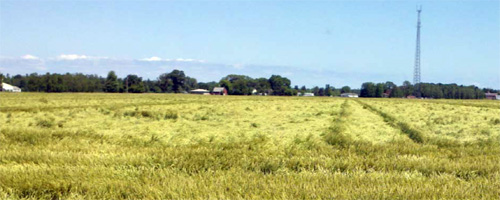Contributing factors and harvest concerns for lodged wheat
Determining the contributing factors leading to wheat lodging can help refine future management practices, but awareness of the quality concerns with lodged wheat is essential at harvest.
Lodged wheat has been observed in a number of fields across Michigan in the last several weeks. High winds from storms are typically the culprit for this lodging, but a number of contributing factors play into the severity of lodging. While lodging in the field can offer some visual clues to management issues, the larger concern at this point may be how to deal with down wheat at harvest. The importance of quality measures in wheat adds another level of complexity in dealing with down wheat at harvest.

There are several main causes of lodging due to stem breakage this year. Most wheat varieties can tolerate relatively high winds without falling over. For lodging to become a significant issue, one of several problems that weaken the stem is typically present.
Root and crown diseases may be more important this season. The most common diseases to cause stem breakage include take-all and sharp eyespot. Both are caused by fungal pathogens that tend to cause a blocking of the vascular system, resulting in the starved heads appearing bleached. As is common with fungal pathogens, wet conditions favor development. Symptomology often includes a blackening of the roots and lower stem. Eyespot also tends to show an eye-shaped lesion at the stem base. The stems of infected tillers readily break just above the soil line.
Insectscan also cause stem breakage. Perhaps the most common culprit is wheat stem maggot. Other suspects include sawflies and Hessian fly. Their feeding is often conspicuous upon close examination and typically causes breakage in the mid-section of the stem.
Excessive rates of nitrogen fertilizer can promote vegetative growth to an extent that the plant becomes less stable in high winds. Efforts to increase wheat yields often include more intensive N management, increasing both the number of N applications and overall N rate. Achieving a N management plan that maximizes yield while minimizing lodging potential can be a challenge. Lodging resulting from high N rates is more apparent on headlands and overlaps where the fertilizer is double applied.
Mineralization of organic N sources can lead to excessive crop N uptake just the same as from high rates of mineral N. Availability of N from previous crops and manure can be tricky to predict in the best of years, but the wide variability of PSNT tests run this spring illustrates how that estimation can be even more difficult in an unusual weather year such as this one. Underestimation of the N contributions from cover crops, previous rotation crop, manure or organic matter can result in plant N uptake that makes the plant susceptible to stem breakage. The benefits of cover crops or manure in the production system usually outweigh any negatives, but they do sometimes add an additional layer of unpredictability.
High tiller densities can contribute to lodging. Weak stems due to high populations can be the result of planting relatively early in the fall (within a few days of the Hessian-fly-free date) without reducing seeding rates or starter N.
Dealing with lodged wheat in the field at harvest is often an issue. It’s understandable to equate leaving lodged wheat in the field to leaving yield in the field, but downed wheat can have significant effects on quality. Lodged wheat tends to trap moisture, making the micro-environment conducive for disease development and grain quality losses. In addition to losses in test weight, both Deoxynivalenol (DON) and falling number scores can be adversely affected.
A second serious risk associated with lodged wheat is that it tends to carry fecal material from deer. Inevitably, some of this material is picked up by the combine and carried with the grain to the elevator where standards require a zero tolerance. Including even small amounts of poor quality lodged grain from a field has the potential to result in the rejection of entire truckloads. To avoid the risk of contaminating loads of wheat, a small amount of wheat could be harvested and evaluated by a local grain elevator.



 Print
Print Email
Email


